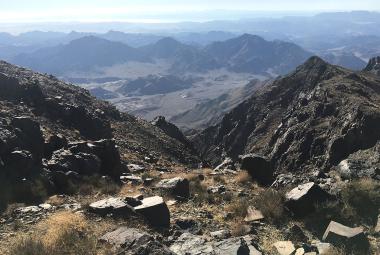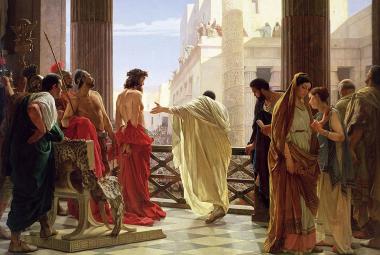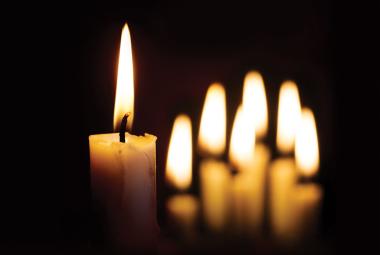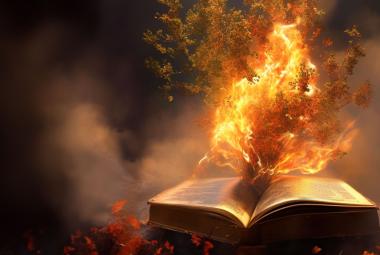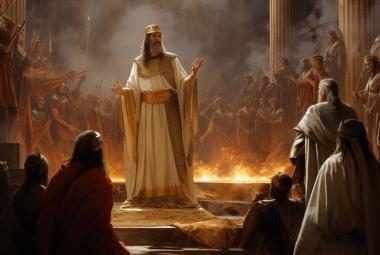As discussed in Part 1 of this series, the treacherous trio of Ezekiel 38 is defined as Turkey, Iran and Russia. Historically, each of these countries enjoyed grand imperial pasts. All are ambitious. All are making a move to achieve a measure of their previous success.
The focus of Part 2 of our discussion of the ill-fated “band of brothers” described in Ezekiel 38 is Iran. Biblically and historically, the geographic region of Iran has also been referred to as Elam and Persia. It is the glory of these past empires to which Iran currently aspires.
Persia Takes Shape
The region boasts one of the world’s oldest continuous major civilizations with evidence of urban occupations dating back to 4000 B.C. The Medes are credited with unifying the region into the Persian Empire in 625 B.C.
Between 550-330 B.C. the Achaemenids were the first of the Persian empires to rule over the Middle East, Greece and Central Asia. Following the conquest by Alexander the Great, rule transferred to the Seleucids, the Parthians, and the Sassanids which governed the region for more than 1,000 years.
Historically, Persia often found itself caught up in the affairs of other nations—invaded and occupied at varying times by Arabs, Turks, Mongols, Brits and Russians. However, Persia has managed to always regain its distinct national political and cultural identity.
Islamization of Persia
A major turning point came for Persia with the end of the Sassanid Empire and the Islamic conquest. This conquest came during the 8th to 10th century and led to the decline of the prevalent Zoroastrian religion in Persia. As in previous “take-overs,” the achievements of previous Persian civilizations were not lost, but were absorbed by the new Islamic polity. Seyyed Hossein Nasr, Professor of Islamic Studies at George Washington University, is quoted as saying:
If the Achaemenian period is the golden age of Persia politically and the Sassanian period in administration, city planning and architecture, the first centuries of the Islamic period are without doubt the golden age of Iranian history in the domain of the sciences, particularly medicine and mathematics. To this period belong those Persian scientists who stand among the foremost stars in the firmament of the history of science to this day.
By 1501, the Safavid dynasty established Shi’a Islam as the official religion of their united Persian state. Iran then became a monarchy ruled by a shah (emperor) until 1979.
Persia Becomes “Iran”
In 1935, the government request was made that all countries with diplomatic relations with Persia begin to refer to the country as Iran. It is reported that the Persian ambassador to Germany suggested this change following the recommendation by the German Nazis.
The intent of the name change was to signal a new beginning for Persia, which had recently come out of the crippling rule of the Qajars (influenced by Britain and Russia). It was at this time the Germans, who were in the midst of their own racial issues touting the Aryan race, suggested Persia also harken back to their Aryan roots by adopting a new national identity as “Iran” (derived from “Aryan”). At the time, many Westerners failed to recognize Iran as Persia. Some thought this may have been a “new” country carved out of the remains of the Ottoman Empire like Iraq and Jordan. By 1941, however, the Allied invasion of Iran and the nationalization of its oil industry put “Iran” squarely in the headlines.
Islamic Revolution
Iran started down its current path in 1979 with the Islamic Revolution (also referred to as the Iranian Revolution), when the country was transformed from a monarchy under Shah Mohammad Reza Pahlavi to an Islamic Republic under Ayatollah Ruhollah Khomeini. Ayatollah Khomeini encouraged dissatisfaction within the public with regards to the Shah’s pro-Western policies and corruption during his exile in France.
Shah Pahlavi left the country for exile in January 1979 and Ayatollah Khomeini arrived from exile in February 1979. A new theocratic Constitution was approved and Ayatollah Khomeini became the Supreme Leader of the country. Iran officially became the Islamic Republic of Iran on April 1, 1979 when the Iranian people voted overwhelmingly to do so.
Upon Khomeini’s death in 1989, Ayatollah Ali Khamenei was appointed the Supreme Leader. These are the only two men to have held this office since 1979. The Supreme Leader is responsible for the delineation and supervision of “the general policies of the Islamic Republic of Iran,” which necessitates that he:
• Establish the direction of domestic and foreign policies;
• Serve as commander-in-chief of the armed forces;
• Control the intelligence and security operations;
• Hold absolute power to declare war or peace;
• Appoint and dismisses the leaders of the judiciary, the state radio and television networks;
• Serve as the supreme commander of the Islamic Revolutionary Guard Corps;
• Appoint six of the twelve members of the Council of Guardians (the powerful body that supervises the activities of Parliament and determines which candidates are qualified to run for public office).
[By the time this article is published, the Iranian Presidential election of June 12, 2009 will be decided. It is apparent by the powers associated with the Supreme Leader that the President is a figurehead of public policy, not the decision maker. The outcome of the election is irrelevant to the direction of Iran’s critical policies regarding its nuclear program and attitudes toward Israel.]
Iran Partners with Russia
Iran’s most ardent benefactor is Russia. Iran and Russia have moved steadily toward increased cooperation over the past 20 years. Since 1992, Russia supplied Iran with hundreds of major weapons systems including: T-72 battle tanks; air-to-air missiles; MiG-29 combat aircraft; SA-15 Gauntlet surface-to-air missile defense systems; and TOR M-1 air-defense missile systems.
Currently in negotiation between Iran and Russia—and under severe protest from Israel—is the sale of the S-300 anti-aircraft missiles, which can fire at multiple targets up to 150 km (90 miles) away and can travel at more than 2 km (1 mile) per second. Israel presumes this purchase is to defend the Russian-built nuclear reactor at Bushehr and other nuclear processing sites.
In the post-Soviet period, both Tehran and Moscow began to view their cooperative relationship as “strategic.” Each side viewed the other as integral to its own national security, internal stability, and territorial integrity. Additionally, both view their cooperation as an important tool toward three ends: preventing U.S. hegemony in world affairs; maintaining what they refer to as a “multipolar” world; and undermining U.S. efforts to sideline or boycott either of them.
Russia does not share the U.S.’s concerns regarding Iran and views its relationship as a means of ensuring Russian interests in the Middle East and Caspian regions are taken into consideration. Russia will not jeopardize its relationship for fear of U.S. short-term material incentives or threats of condemnation. Furthermore, any attempt by the U.S. to link Russia’s cooperation in this sphere with programs that are more important to the U.S. than to Russia—such as the processing and storage of Russia’s fissile materials—is unlikely to be effective.
However, analysts believe that “if” cooperation develops between the U.S. and Iran, a dramatic shift in the nature of relations between Russia and Iran could occur. While Moscow is working to prevent and undermine this possibility, U.S. President Obama’s administration has created quite a stir by extending the olive branch—a move that appears to have created a foreign policy crisis of conservatism in Iran’s June 2009 presidential election.
Iran’s Nuclear Program
Although Iran’s current nuclear program is daily in the headlines, its actual intent to develop nuclear technology has been known since 1974. An August 1974 U.S. national intelligence estimate declared that while “Iran’s much publicized nuclear power intentions are entirely in the planning stage, the ambitions of the shah could lead Iran to pursue nuclear weapons, especially in the shadow of India’s successful nuclear test in May 1974.”
Following the Islamic Revolution, the seizure of the U.S. Embassy hostages, and the termination of diplomatic relations in 1979, U.S. efforts to block Iran’s nuclear efforts increased during the 1980s and 1990s. Additionally, the program was impacted by Ayatollah Khomeini’s opposition to nuclear technology, the exodus of nuclear scientists, and the destruction of Iraq’s nuclear facility by Israel in 1981.
However, Leonard S. Spector, deputy director of the Center for Nonproliferation Studies, suggests there is evidence Iran actually received assistance from Pakistani nuclear scientist A.Q. Khan as early as 1985. After Khomeini’s death in 1989, that Iran’s nuclear efforts reached critical mass.
The program really picked up in January 1995 when Russia picked up where Germany left off in 1975. Russia signed a contract to complete two 950-megawatt light-water reactors at Bushehr with fuel supplied by Russia. In 2008, the Russian company building the power plant reiterated its commitment to finish the project.
Iranian officials also announced that the Darkhovin project dropped by France in 1973 will be resumed with a 360-megawatt reactor to be operational there by 2016. Iran insists that while it has also turned to China, Pakistan, and North Korea for nuclear technology and assistance, it claims it wants to build nuclear power plants to diversity its “energy portfolio.”
To fuel these facilities with domestically produced fuel—which can also be used to develop a weapon—Iran has built a vast system of uranium mines, enrichment plants, conversion sites, and research reactors. Approximately a dozen are considered major nuclear sites. The main facilities which are critical sites in Iran’s nuclear infrastructure are:
Nuclear Fuel Cycle: Two facilities—first at the Nuclear Research Center/Uranium Conversion Facility (UCF) at Isfahan. It employs approximately 3,000 scientists and is suspected of housing a weapons program. It has produced 320 tons of uranium hexafluoride since March 2004. The second facility is the Uranium Enrichment Facility at Natanz: It houses first-generation centrifuges (IR-1) to spin uranium hexafluoride at great speeds to increase the percentage of uranium-235, the principal ingredient for both power production and weapons capability.
Plutonium Production Nuclear Reactor: The Heavy Water Plant and future plutonium production center at Arak.
In a May 2003 statement, U.S. State Department spokes-man Richard Boucher reported:
The disclosure of Arak and Natanz raised serious questions about Iran’s nuclear intentions. We believe Iran’s true intent is to develop the capability to produce fissile material for nuclear weapons using both the plutonium route (supported ultimately by a heavy-water research reactor) and the highly enriched uranium route (supported by a gas centrifuge enrichment plant.
The international debate continues as to whether or not Iran’s nuclear program is for peaceful energy or a way to boost its prowess in the region. Common sense would indicate the latter; however, even the current U.S. President wants to believe it is the former.
Considering the threats of Iran’s current political regime to wipe Israel off the map and the hints in the text of Ezekiel 39 that the results of the Magog invasion entail nuclear cleanup, Russia’s support for Iran’s nuclear program bears watching.
Hints of nuclear weapons in Ezekiel 39:9-15:
• Israel will burn left-over weapons for all energy requirements for seven years;
• Permanent workers or “professionals” are hired to clear the battlefield; they wait for seven months following the battle; then clear for seven months the dead and debris; they bury the dead east of the Dead Sea, which is down-wind from Israel proper;
• Travelers are not to touch anything that is missed in the region, but mark it for the special workers to deal with it.
Turkey: Friend or Foe?
Turkey is considered a moderate Islamic state governed by a secular constitutional democracy. Iran has been considered a terrorist state governed by a radical Islamic Supreme Leader. If Iranian President Mahmoud Ahmadinejad loses his re-election bid, it will signal that Iran is willing to put forth a more moderate face, albeit with no real change in foreign or domestic policies.
Turkey and Iran are posturing to fill the vacuum left in the Middle East with the U.S. presence in Iraq. Historically, when two such expansionary powers interact this closely, they can be driven to conflict or come to an understanding regarding their respective spheres of influence.
Although it is still early in the game, intelligence analysts believe there is more reason for cooperation between Turkey and Iran than there is for conflict. First on the agenda for co-operation is the containment for Iraq’s Kurdish population in the north, which spans Turkey, Iraq and Iran. Second on that list is the fact that Turkey’s ambition to become a major energy transit state would improve with a solid relationship with Iran.
Iran, in the meantime, faces challenges of consensus within its conservative political parties, the completion of its nuclear program, and spreading its influence into the Shiite populations of Iraq.
While Turkey maintains a balancing act of having the advantages of relationship with both East and West, Iran may be deciding whether to stay with an old friend (Russia) or investigate the opportunities extended in an olive branch from an old foe (U.S.).
Regardless of the decision Iran makes, the fact that its leaders desire a “world without Zionism” has not changed. There remains continual chatter of perverse plans to remove Israel from the maps of the Middle East. Unfortunately for them, they haven’t read Ezekiel 38—for God has other plans.
Next month, Part 3 will conclude this series with a look at Russia, its influence in the Middle East (especially its relationships with the players defined in Ezekiel 38), and the reverse influence of Islam on Russian policy.

